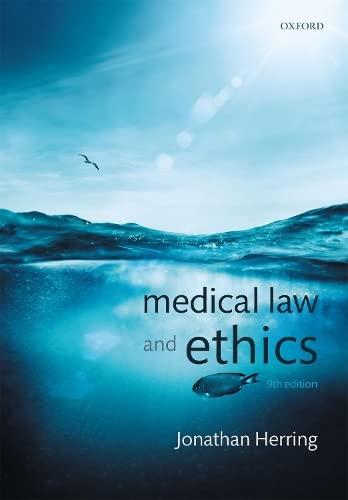Question
Answer all 1.How will a utilitarian act decide when faced with the ethical dilemma presented in the case? Provide a utilitarian balance sheet with four



Answer all
1.How will a utilitarian act decide when faced with the ethical dilemma presented in the case? Provide a utilitarian balance sheet with four primary stakeholders.
2.How will you decide for the ethical dilemma presented in the case based on Kant's categorical imperative?
3.If Merck decides not to go ahead with producing the drug will it or will not affect the employee ethical conduct within the organization. Explain.
4.If Merck decides to manufacture the drug will that be amounting to moral hazard?. Explain.
Case analysis:
Headquartered in New Jersey, Merck & Co. is one of the largest pharmaceutical companies in the world. In 1978, Merck was about to lose patent protection on its two best-selling prescription drugs. These medications had provided a significant part of Merck's $2 billion in annual sales. Because of imminent loss, Merck decided to pour millions into research to develop new medications. During just three years in the 1970s, the company invested over $1 billion in research and was rewarded with the discovery of four powerful medications. Profits, however, were never all that Merck cared about. In 1950, George W. Merck, then chairman of the company his father founded, said, "We try never to forget that medicine is for people. It is not for the profits. The profits follow, and if we have remembered that, they have never failed to appear. The better we have remembered that, the larger they have been." This philosophy was at the core of Merck & Co.'s value system.
RIVER BLINDNESS
The disease onchocerciasis, known as river blindness, is caused by parasitic worms that live in the small black flies that breed in and about fast-moving rivers in developing countries in the Middle East, Africa, and Latin America. When a person is bitten by a fly (and some people are bitten thousands of times a day), the larvae of the worm can enter the person's body. The worms can grow to almost two feet long and can cause grotesque growths on an infected person. The real trouble comes, however, when the worms begin to reproduce and release millions of microscopic baby worms into a person's system. The itching is so intense that some infected persons have committed suicide. As time passes, the larvae continue to cause severe problems, including blindness.
In 1978, the World Health Organization estimated that more than 300,000 people were blind because of the disease, and another 18 million were infected. In 1978, the disease had no safe cure. Only two drugs could kill the parasite, but both had serious, even fatal, side effects. The only measure being taken to combat river blindness was the spraying of infected rivers with insecticides in the hope of killing the flies. However, even this wasn't effective since the flies had built up immunity to the chemicals.
MERCK'S ETHICAL QUANDARY
Since it takes $$200 million in research and $12 years to bring the average drug to market, the decision to pursue research is a complex one. Resources are finite, so dollars and time have to go to projects that hold the most promise in terms of making money to ensure the company continues to exist as well as of alleviating human suffering. This is an especially delicate issue when it comes to rare diseases, when a drug company's investment could probably never be recouped because the number of people who would buy the drug is so small. The problem with developing a drug to combat river blindness was the flip side of the "orphan" drug dilemma.
346 SECTION IV ORGANIZATIONAL ETHICS AND SOCIAL RESPONSIBILITY
certainly enough people suffering from the disease to justify the research, but since it was a disease afflicting people in some of the poorest parts of the world, those suffering from the disease could not pay for the medication.
In 1978, Merck was testing ivermectin, a drug for animals, to see if it could effectively kill parasites and worms. During this clinical testing, Merck discovered that the drug killed a parasite in horses that was very similar to the worm that caused river blindness in humans. This, therefore, was Merck's dilemma: company scientists were encouraging the firm to invest in further research to determine whether the drug could be adapted for safe use with humans, but Merck knew it would likely never be a profitable product.




Step by Step Solution
There are 3 Steps involved in it
Step: 1

Get Instant Access to Expert-Tailored Solutions
See step-by-step solutions with expert insights and AI powered tools for academic success
Step: 2

Step: 3

Ace Your Homework with AI
Get the answers you need in no time with our AI-driven, step-by-step assistance
Get Started


